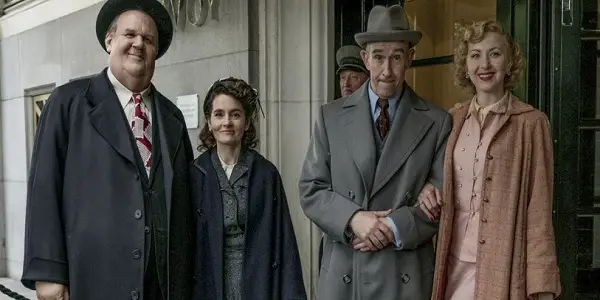For a biopic encircling one of the most famous slapstick double-acts in history, there’s actually very little genuine slapstick present in Stan & Ollie. Foregoing the grit of his previous Filth and Cass, Jon S. Baird’s Laurel and Hardy tribute is conspicuously smooth-edged, albeit lodged with the sort of endearing honesty that makes (however lacking the zip-zap rhythm of their prolific skits) an undeniably sweet testament to the pair’s final years.
A Strikingly Tired Laurel And Hardy
A brief overture joins Stan & Ollie in 1937, at the peak of their career as the iconic ‘Laurel and Hardy’. Cinematographer Laurie Rose starts us off slow, tracking the two as they wander the set of their new comedy western, Way Out West, with the comfortable sheen of a breezy Hollywood picture. It’s hard to imagine Laurel and Hardy ever being this talky, and those coming to Stan & Ollie expecting a light slapstick affair may initially be taken aback to see the duo instead discussing routine ideas contract deals. Yet, as they alternate fluidly between ideas mere seconds before shooting their opening dance number, it’s effective confirmation of the intimate bond the two clowns shared.
Come the 1950’s, things are a tad different. The notoriously fastidious nature of Steve Coogan’s Stan Laurel has permeated his relationships with studios, while John C. Reilly’s Oliver ‘Babe’ Hardy is but an ailing shadow of his twinkly, finger-waggling young self. Reluctant to retire and on the rocks with ex-producer, Hal Roach, Stan hopes to strike a contract with 20th Century Fox, to finance the Robin Hood movie he believes will save himself and his partner’s petering career.

As vaudeville steadily dwindles against the rise of consumer television, the cutely-dubbed ‘Rob ‘Em Good’ becomes the Stan and Ollie equivalent of the American Dream. They weave fancifully between drafted movie bits and improvised skits to hotel staff, as if yearning to return to an era in which they were at the top of their game. There’s a lovely scene involving a pair of curtains and a gag about height; a delightfully simple bit that would’ve had a hard time landing were it not for Reilly and Coogan’s honest performances.
But mostly, this is a heartfelt, often sombre dramatization of the conditions that lead to the double-act’s decline. As the passion project struggles to impress major studios, the pair is relegated to tired Laurel and Hardy reruns in deserted theatres in desperate pursuit of exposure. At points, these scenes make for surprisingly uncomfortable viewing; you can see them sweating as they recycle old material for ten-some audiences, while their money-hungry agent bites his fist with surrogate humiliation. It’s a sad portrait of a duo who – for many – still hold so much joy; one only deepened by the present-day knowledge that the mythical Rob ‘Em Good never came to light. “I guess nobody wants to see Laurel and Hardy anymore,” comes Laurel’s bitter realisation.
Shirley Henderson and Nina Arianda Make A Scene-Stealing Duo
It’s true to say that most of the emotional involvement owes itself to the warm kinship sustained between the two leads, for Jeff Pope’s passing script leaves some to be desired with its transitory joke-telling and (albeit very occasionally) baggy dialogue. Oddly, Stan & Ollie’s own comedy has very little to do with Stan and Ollie at all, arising instead from the hilarious double-act sustained between Shirley Henderson and Nina Arianda. Lucille Hardy and Ida Kitaeva Laurel are the real chalk and cheese of Stan & Ollie, commanding louder and more genuine laughs than anything provided by their doltish husbands.
Baird does, however, make quite clear he isn’t interested in merely quoting the Laurel and Hardy back catalogue. Between Laurel’s unrequited regret having never reached the greatness of Chaplin, and the spiralling health issues that troubled Oliver Hardy until his death in 1957, the duo’s struggle for relevance is couched in a fear of losing a life’s passion, and whatever lacks in comedy is at least buoyed by the profound devotion the couple had to one another as creatives, and as friends. I’m an especial sucker for a vulnerable John C. Reilly, and when content to drop the light chitchat for something more confessional, Pope’s screenplay is filled with the deep, sighing statements that land the performer his most endearing period performance since Chicago.
For the briefest of moments, one wonders if the relationship isn’t actually coercive (Laurel almost seems to be willing his partner on for material’s sake, despite his frequent collapses), but as the curtain rises on what inevitably became the duo’s final performance, it’s doubtless that the reason Laurel and Hardy stayed together so long is simply because they couldn’t imagine a world in which they weren’t. In the words of Reilly’s Babe: “What else are we gonna do?”
Conclusion: Stan & Ollie
Of all the films still to release this year, I can’t imagine many will be more deserving of the word ‘pleasant’ than Stan & Ollie. It’s enjoyable, well-acted and almost entirely undemanding, and in every way as predictable as its strangely rigid clowning routines.
Though ultimately little more than a faithful impersonation of the prolific double-act, it’s difficult to condemn a film whose heart is so firmly placed. For all its superficiality, there’s a warmth to Coogan and Reilly’s central partnership that – all stiltedness noted – deserves the faint smile it leaves you with.
Stan and Ollie premiered at the London Film Festival on October 21 2018. All release dates can be found here.
Does content like this matter to you?
Become a Member and support film journalism. Unlock access to all of Film Inquiry`s great articles. Join a community of like-minded readers who are passionate about cinema - get access to our private members Network, give back to independent filmmakers, and more.